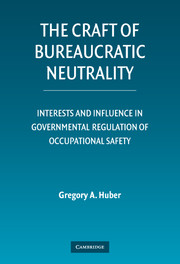 The Craft of Bureaucratic Neutrality
The Craft of Bureaucratic Neutrality 1 - Bureaucratic Power and Strategic Neutrality
Published online by Cambridge University Press: 27 July 2009
Summary
One of the core questions of governance is whether citizens and their elected representatives can control the apparatus of the state. In the contemporary era, where administrative agencies staffed by unelected bureaucrats must implement broad and uncertain mandates, control of how agencies execute the law has gained even greater significance. At the same time, extensive political “meddling” in the details of policy implementation threatens to yield agencies so hamstrung by external intervention that they are incapable of effectively executing policy. Political control, in short, may come at the cost of capable public administration.
This chapter examines the dominant accounts within political science and public administration of whether and how elected officials and interest groups shape bureaucratic decisions. These perspectives include the assertion that the bureaucracy is ungovernable or guided by bureaucrats' professional training and beliefs, theories of congressional dominance and agency design, and claims of direct and indirect interest group capture. These viewpoints are used, in both academic and common discourse, to explain “why government agencies act the way they do.” They highlight, among other factors, internal bureaucratic norms, the influence of congressional committees and legislative statutes, and interest group power in explaining how agencies enforce the law. They do little to explain regulatory enforcement and implementation, however, because they understate the linkages between the internal management of bureaucracy and external political conflict.
- Type
- Chapter
- Information
- The Craft of Bureaucratic NeutralityInterests and Influence in Governmental Regulation of Occupational Safety, pp. 13 - 46Publisher: Cambridge University PressPrint publication year: 2007
- 1
- Cited by
